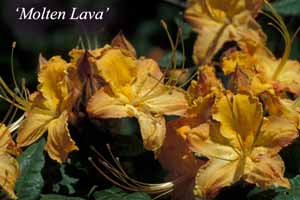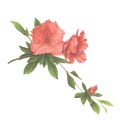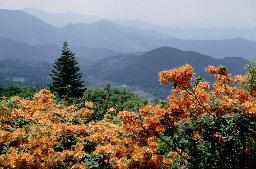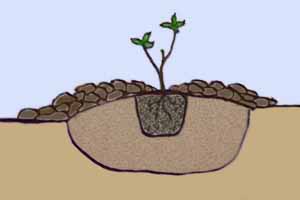| Contact |
|
Rhododendron calendulaceum Thomas Jefferson Elementary Ecology Club Earth Day: April 22, 2004 | |
What are Native Azaleas? There are many types of azaleas in our gardens but most of the ones we grow are not native plants. The familiar red, pink, white, or purple azaleas in our gardens came primarily from Japan. However, there are 16 species of azaleas native to the United States, plants that were growing here long before the Pilgrims or the even native American Indians arrived. Fossil evidence indicates these native azaleas probably evolved during the age of dinosaurs, before the continents had moved apart.
There are many types of azaleas in our gardens but most of the ones we grow are not native plants. The familiar red, pink, white, or purple azaleas in our gardens came primarily from Japan. However, there are 16 species of azaleas native to the United States, plants that were growing here long before the Pilgrims or the even native American Indians arrived. Fossil evidence indicates these native azaleas probably evolved during the age of dinosaurs, before the continents had moved apart.
The Flame Azalea, or Rhododendron calendulaceum (pictured to the right), is one of our most spectacular native azaleas. Its flowers come in shades of yellow, gold, orange, or red. People often do not realize that all azaleas are actually Rhododendrons but unlike most plants in that genus, the native azaleas drop their leaves before winter so they are called "deciduous" azaleas. The Flame Azalea was named Virginia's "Wildflower of the Year" in the year 2000 but not many people in our state grow this beautiful plant.
Before the first Colonists arrived, the Flame Azalea grew naturally from New York, through Pennsylvania and Ohio, southward through Virginia and the Appalachian mountains, to northern Georgia. Early explorers spoke of seeing entire hillsides ablaze in color when the azaleas were in bloom. Over-development and environmental stresses have hurt many populations so plants are quite rare now. However, some impressive displays still remain in National Parks or Forests, and along the Blue Ridge Parkway from Roanoke to the Smoky Mountains. Your plant came from seed collected along the Appalachian Trail near Roan Mountain. Remember, never dig up wildflowers in nature but leave them for others to enjoy. You can buy plants from a nursery, or better yet, learn how to raise rare plants like native azaleas from seed so everyone can have more of them. How to Plant Your SeedlingMost azaleas produce lots of seeds but they are very tiny and few survive. If seeds do germinate they grow slowly at first, so weeds or other plants usually choke them out before they get established. When azaleas do get larger they begin to grow much faster, often increasing 8 to 12 inches in height each year. This native azalea seedling was started on January 1st, 2001, so it is already over 3 years old but still quite small. Don't expect any blooms this spring but with proper care, your plant could flower next year or perhaps the year after.Flame Azaleas do not like dense shade, so find a place in your garden that gets at least several hours of direct sunlight. Native azaleas do not like dry soil either. They prefer a rich, moist woodland soil containing plenty of organic matter, or humus. The soil must be "well drained" since azaleas are not happy in heavy clay soils or areas where the water forms puddles that last a long time after it rains. Be careful of areas where deer or bunnies like to graze because they do eat azaleas.
When you plant an azalea, dig a wide hole and add some soil improvements such as leaf mold or humus collected from the woods, small pine bark chips, or peat moss. The hole should be wide, 1 to 2 feet across, but not too deep. Azaleas have a shallow root system so 6 to 8 inches in depth is usually fine. Never plant an azalea deeply because its roots can smother. Plant your azalea at the same level or a little higher than it was in the pot. Water your plant well and put some mulch around it to keep the soil cool and moist. Mulch also keeps weeds from growing. Continue watering over the summer but don't overdo it! Too much water can kill the azalea's roots. Azaleas do not want much fertilizer or any lime since strong chemicals can also hurt the roots. If your azalea is happy, it will begin to send up stronger shoots each year and eventually set large round flower buds on branch tips by fall. Expect it to bloom the following spring and get more beautiful every year. Some Other Useful Links
|
||


